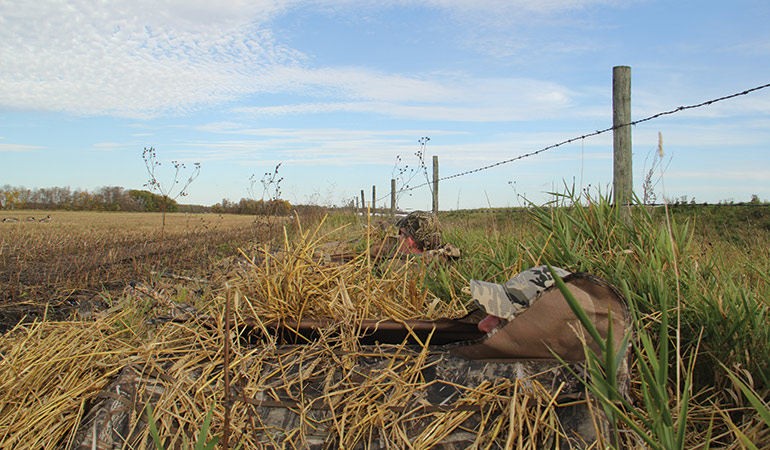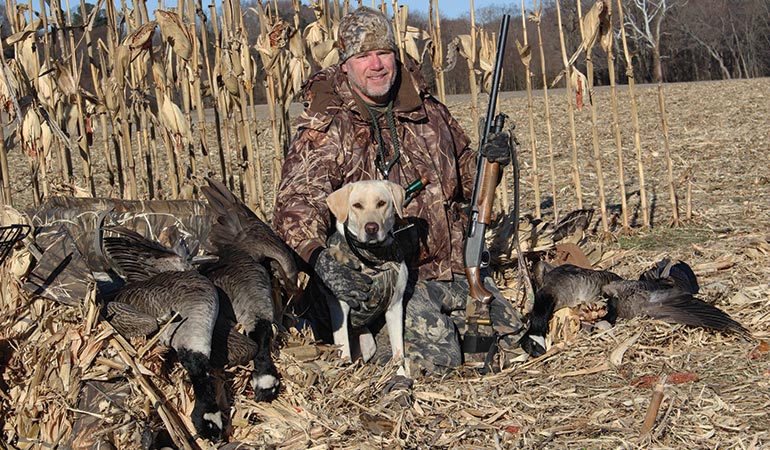
Most of us that read waterfowl articles in magazines dream of the wild hunts on massive grain fields teeming with thousands of geese and ducks. But what about the guy or gal that does not have a trailer full of high-end decoys, access to thousand-acre fields, and cannot afford expensive calls? There are plenty of hunters out there itching to call in their own birds, and see wobbling gray and black bombers with feet down, and hear the grunt of the honkers as they cruise within range with cupped wings. All of us want to yell, “Take em!” as we bust out of our layouts, dropping geese.
The good news is that any of us can live that dream with some planning and effort, even without access to big feeds and hundreds of decoys. In fact, fields less than 100 acres that are located in a daily flight pattern near water are killer locations, particularly later in the season. Throw in two-dozen decoys, a flag and a few layouts and you are in business.
Table of Contents
Lighting the Flame
A few seasons ago my daughter and I were trying to do a little duck hunting on a tributary of our local river in Virginia. A farmer granted us access to a makeshift boat ramp at the end of the fields. Our duck hunting was a bust due to lack of birds, but we noticed a few small flocks of geese regularly passing over the scattered 50-acre grain fields that we dragged our boat through each morning going to and from the water.
When we stopped to pay the boat ramp access fee to the farmer, I left a “thank you” note commenting about how we noticed Canada geese flying over the fields, and how none of those birds came near our blind or the part of the creek we hunted.
A week later when we were leaving the same property the farmer stopped us and asked if we wanted to try to put a dent in the flock of geese to help save the crops. We could hardly contain our excitement, and promised to not tear up the fields—and insisted on continuing to pay the access fee.
Location Is Paramount
Since we lucked into that field to hunt, we have since started gaining access to other small, but similar fields. When looking for productive fields, we start scouting in the fall when geese filter in from the north. We use an online topo/satellite map and our online GIS maps for our local counties to locate farm fields near water sources around the Chesapeake Bay watersheds. These can be large swamps, ponds, large creeks, rivers or small bays. Smart hunters know Canada geese will roost on the water and then feed after the sun gets up.
Once we locate potential properties near where we live, we try to scout them before approaching the farmer. Binoculars are helpful. We watch for flight patterns to determine which properties the birds tend to fly over on a regular basis when going to feed and roost. Again, we focus on small fields under 100 acres that geese have flown over on a regular basis. They don’t necessarily have to feed in the small fields, but there should be some beans or grain of some sort for them to eat if they did land in the field.
While other hunters are hitting the large fields and putting in a lot of effort and time with dozens, or even hundreds of decoys, we are going light with two-dozen or less decoys and pulling down our limits right along with the big shots with all their equipment.
Hiding Is Everything
Since we are on a budget, we carefully select two-dozen field decoys of various poses, a few layout blinds from a box store retailer and a flag for motion. While it would be nice to get the top-of-the-line gear, we make do with what we can afford and make a point to take care of it to make it last. One of the things we do with our layouts is gather up stubble from the fields we are hunting a few days before and very thoroughly brush our layouts. We also take a few trashbags and rake up stubble from the ends of the fields and use it the day of our hunt to “feather out” the profile of our blinds and our dog blind too. It is critical to blend the blinds in as much as possible.
Steve Purks, a friend and self-taught goose hunter, explained how critical this was to us.

Geese that arrive in Virginia or Maryland after Thanksgiving when our season opens are wary and have been called to and shot at.
When we place our decoys in the field, we face a majority of them into the wind while leaving a hole for the birds to land in our kill zone; another trick we learned from Purks. We watch how the birds react to our set up and make changes as necessary. Sometimes we need to open the hole if the birds seem hesitant or sometimes we change the direction the decoys are facing if the wind shifts. Purks is always checking conditions and analyzing his spreads when we hunt with him and I keep a close eye on what he is doing and ask a lot of questions to learn as much as I can.
Next, we use the terrain to our advantage. A few rows of corn were left standing in one of the fields we hunted last season. We backed our blinds up to that hard edge and made them all but disappear. While the geese did not want to land right on our blinds, they did come in close enough for us to get our shots. We have also placed our blinds in spots that were slightly lower than the rest of the field. Doing so helps the layouts disappear and we have our decoys all around the layouts to blend in. Fencerows or hedgerows are great for this if the wind is correct for the setup of decoys. Birds won’t land if the wind is blowing towards the hedgerow; it leaves too little time for the birds to get down in the decoys. Hunters need the wind blowing away from the hedgerow for a good setup.
Last, we use inexpensive calls, but they work. We use them sparingly, mostly for getting the attention of the geese from a distance and a little grunting as they pass over. We flag the birds when they are coming off the water and heading to the bigger fields nearby. By being in the flight path, we get their first looks and then work hard to peel off birds and get them curious before they even make it to the larger fields. All it takes is a few to commit and come on down for us to get our shots and watch the dog work!
One last tip is to be in place early whether it is a morning or afternoon hunt. When the birds go to feed you want to be in place when they start flying or they will see birds landing a half-mile away and keep following them. Be at the front of the flock when they come over and work those birds.
Small Investment, Big Rewards
Hunting small fields on a shoestring works for several reasons. First, the geese sometimes get wary of the larger fields and large spreads of decoys and they begin to look for something different, something a bit more secure. Sometimes the group of birds will peel off the big flock looking for food. Being in the flight path, carefully positioning our decoys and layouts by using and considering the terrain in the field, and calling sparingly but using a flag to attract their attention, really makes a difference for us. We don’t need to purchase a trailer load of high-end decoys or spend hundreds of dollars on a lease and expensive calls to get our limits. It works, and we spend far less money and time setting up to have our fun.











































